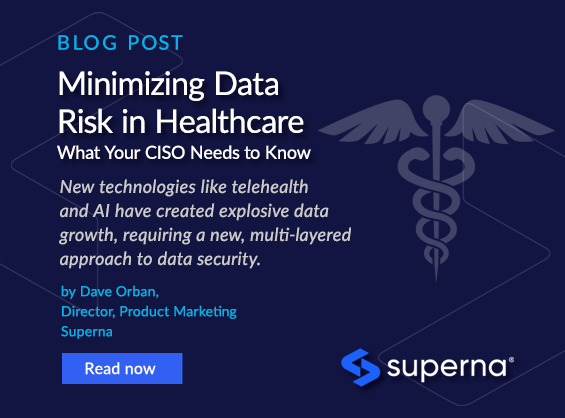Minimizing Data Risk in Healthcare: What your CISO Needs to Know
- Date: Aug 20, 2024
- Read time: 9 minutes

Explosive data growth and new technologies have increased the challenge of securing critical healthcare data.
Healthcare data security contains sensitive information that must be adequately protected against unauthorized access, loss, and destruction. Insufficient data security can lead to disastrous patient outcomes, reputational damage, costly fines, and lost business. In 2023 alone, 80% of the 739 reported healthcare data breaches were due to hacking or IT incidents, and the number of hacking cases continues to increase almost daily.
Healthcare records have become a popular target for a simple reason: Medical records are worth up to 40x more than stolen credit card data on the dark web. Why? Health records can include everything from Social Security numbers to health plan beneficiary information and even biometric identifiers… and often include financial account information.
Digital transformation in the healthcare industry has created an emerging ecosystem in which the delivery of healthcare is completely dependent on data. Connected devices collect vitals and other patient health information that later become the basis for care protocols. Electronic heath records (EHRs) store information and drive care workflows that can run the gamut from authorizing procedures to prescribing medications. Everything from the simplest to the most complex and advanced treatments are now delivered using digitally-enabled technologies. As more and more providers begin to integrate third-party technologies and web-based platforms into their practices, the attack surface has expanded greatly, and a bold new, proactive approach to data security has become essential.
Modern attack surfaces are inherently dynamic and constantly shifting, moving and growing over time. This is particularly true of unstructured data, with explosive growth fueled by the rapid adoption of Artificial Intelligence (AI) and Machine Learning (ML). Attackers are becoming increasingly adept at scanning the internet in search of vulnerable systems and exploiting gaps in security before they can be patched. Given the multitude of ways in which a bad actor can make their way into your network, the traditional, perimeter-based approach to data security is no longer adequate. A layered approach to data security is rapidly becoming the new gold standard for data protection.
As with most breaches, the typical entry points include:
- Inadequate security training for employees. The human factor continues to be the biggest security weak point, whether via a phishing link, lost or shared credentials, or even allowing unregistered users onto the computer network.
- IT departments with limited resources. Staffing and budget shortfalls can mean deferred technology updates; lack of defensive hardening; and inadequate training to understand and respond to new and emergent cyberthreats.
- Introduction of Telehealth into the overall mix. The COVID pandemic introduced telehealth to the world, and it’s become a significant component of the healthcare delivery ecosystem. Patients and providers engaging with healthcare outside of the traditional data security “perimeter” has created a host of new and highly attractive attack vectors.
- An evolving regulatory environment. New and emergent regulations such as the 21st Century Cures Act of 2016. Designed to reduce systemic barriers and speed the development of medical products and services, the Cures Act has the potential to support and even accelerate technological innovation, but it has also created additional vectors through which data can be leaked or stolen in transit.
- Insider threats. There are several types of insider threats, each with different goals, including careless or negligent workers; malicious insiders; inside agents; disgruntled employees; and outside contractors. While many companies tend to invest more around insider threats with malicious intent, purely negligent insider threats are much more common, but can be equally problematic.
Data security fundamentals
Some simple steps you can take to bolster your security posture include:
- Regular security training. A properly-trained employee is far less likely to make errors in judgment that can result in a security breach. Many organizations have told us that their employees see security policies and/or receive security awareness training less than once a year. Given the speed with which new security threats emerge, it’s critical that your employees know what to look for, and what steps to take in the event of a possible intrusion.
- Strong, credential-based authentication. Limit, control, and monitor physical and digital access to spaces, assets, and data. Provide your authorized users with high-assurance, credential-based authentication that allows them to quickly and easily authenticate their identity and confirm their access privileges.
- Digital certificates. A robust digital certificate program can complement strong authentication in confirming the identity of a user, device, or server.
- Data protection. Protected health information (PHI) should be encrypted – both at-rest and in transit – unless a “reasonable and appropriate” justification is given.
- Secure critical infrastructure. The ways in which critical infrastructure can become insecure are numerous. As just one example, out of the more than 600 incident response cases monitored last year by Palo Alto Network’s Unit 42, poor patch management contributed to an astonishing 28% of all successful breaches!
Protecting the perimeter is no longer enough
Modern attack surfaces are inherently dynamic and constantly shifting, moving and growing over time. This is particularly true of unstructured data, with explosive growth fueled by the rapid adoption of Artificial Intelligence (AI) and Machine Learning (ML). Attackers are becoming increasingly adept at scanning the internet in search of vulnerable systems and exploiting gaps in security before they can be patched. Given the multitude of ways in which a bad actor can make their way into your network, the traditional, perimeter-based approach to data security is no longer adequate. A layered approach to data security is rapidly becoming the new gold standard for data protection.
What is a Layered Security Strategy?
In layered security, each element plays a distinct role in safeguarding against threats. In the simplest terms, it involves using multiple security measures simultaneously to protect your digital assets. The presumption is that no single security measure by itself is adequate. By employing different types of security tools and methods, you can create a much stronger system of defenses. In the context of cybersecurity, this might include physical measures like secure access to buildings; and organizational policies that mandate strong passwords for employees; along with technical tools like firewalls and malware detection software. Each layer is designed to address different types of threats or provide additional barriers to potential attackers. And if one layer fails, others remain in place to help keep your critical data safe. Properly conceived and deployed, it’s a dynamic defense strategy that continually evolves to meet the challenges posed by new threats, helping to mitigate risk and minimize business disruption.
Security at the data layer
As data growth continues to expand the storage footprint, it creates a much larger attack surface, one in which traditional perimeter safeguards are no longer sufficient. Data layer security is the monitoring of actual data packets in order to detect – and respond to – attempts to compromise networks and applications. Keeping a record of everything that happens on your site can be invaluable, especially after a security incident. An activity log can track changes, logins, and updates, making it easier to pinpoint how and when a breach occurred. This insight can both guide your response and help strengthen your defenses against future attacks.
Superna’s approach to security is unlike that of a typical data protection solution. Even in the event of a perimeter security failure, Superna software remains alive and well, protecting the data at its source. And while endpoint protection and traditional backup and recovery solutions are critical, the value of a multi-layered approach to data security is clear. Superna runs in a controlled deployment inside the datacenter and is complementary to the traditional backup and recovery solutions that are commonly in use today. So, in scenarios in which endpoint security was compromised, Superna solutions remain unaffected, running in the background, monitoring and analyzing data access, and can spring into action as necessary. By continuing to secure the data, it enables a quicker return to normal business operations. And Superna’s robust integration with leading SIEM and SOAR tools means that you can monitor and manage your Superna deployment from within the security tools you already use!
Key Takeaways
- Driven by modern, machine-generated workloads typical in healthcare, the amount of unstructured data continues to grow at an astonishing pace. Complex and siloed legacy storage platforms often struggle to meet the demands of securing that data.
- This unprecedented growth of business-critical data requires a simple, scalable high-performance solution to both secure and maximize the business value of your file and object data.
- When coupled with an industry-leading storage platform, Superna can help healthcare organizations achieve robust cyber resilience, informed by the best practices outlined in the NIST Cybersecurity Framework, the global benchmark for cybersecurity.
Prevention is the New Recovery
For more than a decade, Superna has provided innovation and leadership in data security and cyberstorage solutions for unstructured data, both on-premise and in the hybrid cloud. Superna solutions are utilized by thousands of organizations globally, helping them to close the data security gap by providing automated, next-generation cyber defense at the data layer.
By focusing on data security at the core, Superna helps ensure that even if your endpoint defenses are compromised, critical data remains protected. This layered approach to data security helps healthcare organizations safeguard their most valuable asset – their data – against both cyberthreats and human error, for improved resilience and business continuity in a world that is increasingly reliant on data. And through robust integrations with industry-leading SIEM and SOAR tools, Superna allows you to monitor and manage your file and object data using the security tools you already have in place.
Superna is recognized by Gartner as a solution provider in the cyberstorage category. Superna… because prevention is the new recovery!
Featured Resources

Mastering Cybersecurity Insurance Negotiations: A Comprehensive Guide

Navigating the Digital Menace: A Beginner’s Guide to Ransomware
